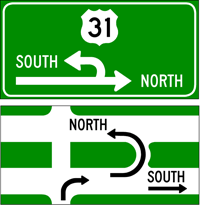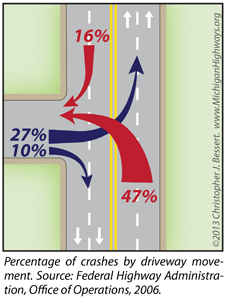The Michigan Left
Contents: Introduction | How it Works | History | Photos & Plans | Other Thoughts
Often maligned, often misunderstood, the Michigan Left turn is an operation which causes much consternation among out-of-state drivers and nary a second thought from locals. Developed in Michigan in 1960 (see History), these turning set-ups exist across the entire state, from Niles to Escanaba and from Detroit to Marquette. (Yes, the Upper Peninsula has Michigan Lefts! At last check, about 30 individual turnarounds.) As of 2010, one MDOT document noted, "In Michigan, there are more than 425 miles of median with directional crossovers on the state highway system."
 The Michigan Left was developed to avoid the interlocking left-turn movements
along divided highways. In this way, the only turning movements allowed at
such an intersection are right-hand turns. Traffic lights can be placed at
busier Michigan Left intersections if warranted. For the most heavily-used "crossovers," specialized
traffic signals may be placed to ensure traffic does not back up on the highway
waiting to turn left.
The Michigan Left was developed to avoid the interlocking left-turn movements
along divided highways. In this way, the only turning movements allowed at
such an intersection are right-hand turns. Traffic lights can be placed at
busier Michigan Left intersections if warranted. For the most heavily-used "crossovers," specialized
traffic signals may be placed to ensure traffic does not back up on the highway
waiting to turn left.
The Michigan Left is often railed against by visitors and those moving to Michigan from other areas. While it is often contrasted with other intersection improvement solutions, such as the New Jersey Jughandle, New England  rotaries, the standard roundabout, and even grade-separated interchanges, studies over the past 50 years keep proving the Michigan Left's worth. Those studies show the average wait times at Michigan Left intersections are much shorter than if that same intersection had a traditional four-phase traffic signal with protected left-turn movements. Plus, the types of collisions which occur at Michigan Left intersections cause less damage, fewer injuries, and costs drivers less. Additionally, the National Highway Institute Research Center reports that "nearly 75% of all access-related crashes [to and from driveways from the main highway] are left turns. The left-turn movement into a driveway, without the benefit of a signal, accounts for 47% of the crashed associated with driveways. Twenty-seven percent of the crashes were turning left out of the driveway. Only 26% of driveway crashes are right-turns (with 16% in and 10% out)." (See graphic at left.)
rotaries, the standard roundabout, and even grade-separated interchanges, studies over the past 50 years keep proving the Michigan Left's worth. Those studies show the average wait times at Michigan Left intersections are much shorter than if that same intersection had a traditional four-phase traffic signal with protected left-turn movements. Plus, the types of collisions which occur at Michigan Left intersections cause less damage, fewer injuries, and costs drivers less. Additionally, the National Highway Institute Research Center reports that "nearly 75% of all access-related crashes [to and from driveways from the main highway] are left turns. The left-turn movement into a driveway, without the benefit of a signal, accounts for 47% of the crashed associated with driveways. Twenty-seven percent of the crashes were turning left out of the driveway. Only 26% of driveway crashes are right-turns (with 16% in and 10% out)." (See graphic at left.)
As for those who constantly complain and insult the traffic engineers who continue to install Michigan Lefts, think about it this way: If Michigan Lefts were truly judged to be more dangerous or ineffective at their purpose, why are they still proliferating a half century later? And why are so many more states and other nations around the world using them or slight variations of them? Hmmm...
How it Works

Red Line traffic on the divided highway cannot turn left directly at the crossroad intersection. To accomplish the left turn, the divided highway traffic moved to the left lane, continues past the crossroad, and turns left into a "median crossover," usually placed about 660 feet beyond the intersection. When traffic clears sufficiently, the left turn onto the opposite direction of the divided highway is completed. The driver then moves to the right lane and turns right onto the crossroad, thus completing the traffic movement.
Green Line traffic on the crossroad wishing to turn left onto the divided highway first turns right onto that highway, moves to the left lane and turns left into the "median crossover" approximately 660 feet from the intersection. When traffic clears sufficiently, the left turn onto the opposite direction of the divided highway is completed.
History of the Michigan Left
The following is excerpted from the publication "The State of Michigan Trunk Line Story," Third Edition, by Stanley D. Lingeman, P.E. Fellow Member, August 15, 1996. From the second chapter titled "U.S. and Super Highways," Mr. Lingeman relates just how the Michigan Left came to be:
The Super Highway, which was originally designed for use in the Detroit area as part of the United States Highway Program of the late 1920s, proved with time to have some operational problems that developed from the traffic growth following World War II.
In 1960, in order to avoid the interlocking of left-turn movements, a number of major intersections along Telegraph Road [US-24] in Wayne County were designed as Super Highway with directional crossovers. The purpose of the directional crossovers was to remove the left turns from the major intersections. The crossovers were placed in the median island about 350 feet from the cross street. Joseph Hobrla, the Department's Signal Engineer, was dissatisfied with the traffic flow characteristics of these intersections on Telegraph Road. He and Joseph Marlow, the District Traffic Engineer [for the State Highway Department], decided to experiment with the westbound Eight Mile Road [M-102] left turn at Livernois Avenue in Detroit. A directional left-turn crossover was constructed in the median of Eight Mile Road at a point 660 feet west of Livernois. A traffic signal was placed on eastbound Eight Mile Road at Livernois to handle the right-turn movement. The operation has proved to be so successful that 700 directional crossovers have been constructed on the trunk line system throughout the state.
The Michigan Left turn treatment continues to be implemented around the state whenever deemed necessary to improve the flow of traffic. In the early 1990s, for example, M-44/East Beltline Ave in the Grand Rapids area, from I-96 northerly to Plainfield Ave, was completely reconstructed as a divided highway with Michigan Left crossovers. Also in West Michigan, US-31 from Holland to Grand Haven is slowly being upgraded to include Michigan Lefts at the busier intersections.
Although Michigan has been using the Michigan Left treatment for over five decades, other states had been slow to experiment with this type of traffic control. However, in recent years other states and municipalities have begun to implement Michigan Lefts due to shrinking transportation budgets and increasing traffic congestion. For example, the North Carolina Department of Transportation has been actively implementing Michigan Lefts as a part of their "Superstreet" program and municipalities in Arizona have gone so far as to rename them as "Arizona Boulevard" turns.
Photos & Plans
- Aerial View of a Michigan Left Configuration along US-41/M-28 at McClellan Ave in Marquette, in the central Upper Peninsula.
- Photo of an Overly Diagrammatic Michigan Left sign along McClellan Ave at US-41/M-28 in Marquette.
- Photo of a Unique Michigan Left/Route Marker Trailblazer taken by Barry Camp, from central Kent County.
- Plans for a Michigan Left Configuration near Grand Rapids where a Michigan Left will be situated on a narrow right-of-way.
Other Thoughts
- Michigan Lefts - after many years of not explaining them on their website, MDOT now has a comprehensive page on them including a Flash demo of how they work.
- Experiment in Reckless Abandon: Michigan Left - a weblog by "Cordelia" who moved to Michigan from California and, while she loves the "greeness" of the state, cannot understand the Michigan Left: "'They'—whoever they are—have decided in their little pointy heads that they can't just allow anyone to make a left turn when they want to. ... You are often forced to go down to the next stoplight and make a u-turn and come back. Obviously that is so much more efficient and better for traffic than just allowing people to make a left whenever the fancy strikes them." Actually... it is!
- The Infamous "Michigan Left" Hand Turn - from Atul Patel's "Detroit Essentials" blog, complete with his own version of a Michigan Left movement graphic.
- How to Turn Left in Michigan - a funny cartoon contrasting how to turn left in Michigan vs. turning left in the Upper Peninsula from the "toothpaste for dinner" website.
- Increased Safety and Efficiency with the Michigan Left - an archived 2011 article from ecogeek.org referencing a North Carolina State University study advocating Michigan Lefts.
- No Left Turn: 'Superstreet' Traffic Design Improves Travel Time, Safety - a release from North Carolina State University regarding their 2011 findings on the operational benefits on the "Superstreet," a slight variation on the traditional Michigan Left.
- The North Central Section of the Institute of Transportation Engineers (NCITE) Geometric Design Committee noted in August 2005 that, "Although committee members noted incidents of strong public opposition to the access closures associated with Michigan Left Turn Lanes, Howard presented data from several states indicating fairly significant decreases in crashes."
- "Turning Right to Go Left" or "Go Through the Light, Then Left, Then Right" (via archive.org) - in a short blog entry from 2003, "Swirlspice" summed up the Michigan Left as "a love-it-or-hate-it gem of traffic engineering."
- Michigan Left Turn divides city, drivers - a 2010 article from the Plano Courier-Star about a reconfigured intersection in Plano, Texas using Michigan Left turns and a bit of controversy resulting from it. A December 2013 article in the same paper notes how those in Plano, Texas forced the city to revert the intersection to its pre-Michigan Left format, even though that could increase wait times by as much as 442%! I'm sure that makes sense... to someone...
- Michigan left turns: Many of us are doing it wrong - A May 2010 article from The Grand Rapids Press about many drivers using the single-lane Michigan Lefts as two-lane turnarounds, which causes accidents.
- Michigan Left in Mexico! - Here's a photo of a Michigan Left diagram sign in Baja California!
- "Hard Left," How the 'Michigan Left' Works - an infographic that appeared in the Indiana Business Journal about the Michigan Left being implemented as the "Fishers Left" in Fishers, Indiana.
- "Michigan Left" by Arkells (YouTube video) - the band Arkells from Hamilton, Ontario released a song ostensibly about Detroit on their 2011 album Michigan Left. It's not really about Michigan Lefts, but it's pretty cool that there's a song and an album out there called "Michigan Left". The track hit No.7 on the Canadian Alternative charts and No.18 on the Canadian Rock charts in 2011.
- You know you're from Michigan when.... These jokes have been going around the Internet for years, but take a look at No. 18 on this list...

